February 27, 2023
Acute at Home a Mental Health Lifeline

Social workers and therapists like Carol Coventry support young people in crisis through Acute at Home.
Donor-supported program helping kids receive care in their own home
Thanks to generous donors, last year, over 1,400 young people facing mental health challenges in our community received the right care in the right place from the Acute at Home program. This innovative model of care ensures children and teens are able to access supports in a way that best works for them and their families. From zoom chats to community coffee shops, to living rooms or school classrooms, Acute at Home clinicians provide comprehensive counselling and connection outside of a hospital setting making it easier for young patients and families to access the care they need when they need it most.
Patients like Kris* who presented at the Alberta Children’s Hospital in crisis this past fall. Struggling with anxiety and despondent, they needed help. Their mom, Maria*, also needed help to know what to do. It was in the Emergency Department that experts assessed Kris’s condition and determined a course of action that would get them the mental health support they needed, in the comfort of their own home.
Shortly after presenting at the Alberta Children’s Hospital, an Acute at Home clinician was at their door. Over the course of two months, Kris would have regular visits with a therapist at their home, or they would go on walks. Different from a clinical setting, these interactions provided the space they needed to open up and express their feelings and work through their crisis with a trained professional. Maria says the visits also provided the clinician with a better understanding of the family dynamics for a clearer picture of her child’s life and needs. “You’re fighting some sort of war you didn’t know existed, and someone comes to the front line with you,” says Maria. “Acute at Home was the biggest gift we could have received.”
Mental health is not an episode, it’s a journey. While Acute at Home helped de-escalate the crisis and helped Kris’s family better communicate and support one another, the work continues. Maria is grateful for the community support that helped get Acute at Home up and running for families like hers. She’s looking forward to the opening of The Summit: Marian & Jim Sinneave Centre for Youth Resilience, which will provide intensive outpatient treatment and other services for young people like Kris in our community.
* names changed at request
Meeting the Emergency Demand
In response to the demand for pediatric mental health or psychiatric services from the Alberta Children’s Hospital Emergency Department, CHOICE appointments were introduced to provide services in the timeliest and most effective way possible.
Here’s how it works:
If a child presents at Alberta Children’s Hospital Emergency triage and is not deemed to be an acute suicide risk, they will then wait to see an Emergency room physician. Once called into Emergency department, the physician will determine if a full mental health assessment is required immediately or if the child is stable and could be seen by an Acute at Home clinician at a scheduled (CHOICE) appointment within the next five days. Giving this option allows the family to determine if they want to wait in the Emergency department for what could potentially be several more hours or if they are comfortable to go home knowing that help will be available in their own home from the Acute@Home team. At the CHOICE appointment, they will undergo a complete psychiatric assessment and, based on those findings, be connected with appropriate services and resources.
CHOICE appointments reduce wait times and allow the Psychiatric team to see the most acute patients more quickly. It also gives families peace of mind that they’re in a safe place and that care is on the way.
Advocating and Coordinating Care
When a child is struggling with mental health, there can be many different services and professionals involved in their care. Oftentimes, Acute at Home clinicians serve as the centre point for coordinating all the different supports, such as school personnel, community-based services and family doctors. Organizing case conferences with all involved parties has resulted in more streamlined and coordinated care for families who are, in many cases, already under great strain. Acute at Home clinicians can also help parents and caregivers advocate for young patients who may be facing barriers to their wellness at school or in the community.
Offering Appointment Options
When the pandemic hit, the Acute at Home team pivoted immediately to ensure children and families could be seen and helped through online video conferencing. With less transit time and quicker appointments, the virtual approach allowed for more children and teens to be seen each day. Some families indicated that the video appointments were more desirable to their children or teens – resulting in increased compliance and participation.
While the pandemic restrictions have been lifted, some appointments are still conducted online. While it is most beneficial to have the first meeting in person in the family home, there is the option to have subsequent appointments via video conference if that works best for the patient and family schedule.
Read more about your impact on families who have benefited from Acute at Home in Where Your Money Goes.



